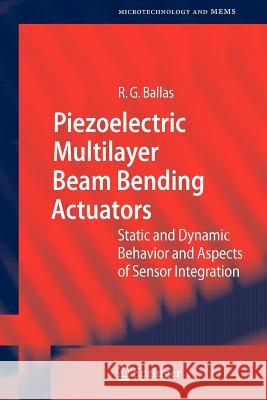Piezoelectric Multilayer Beam Bending Actuators: Static and Dynamic Behavior and Aspects of Sensor Integration » książka
Piezoelectric Multilayer Beam Bending Actuators: Static and Dynamic Behavior and Aspects of Sensor Integration
ISBN-13: 9783642069109 / Angielski / Miękka / 2010 / 358 str.
Piezoelectric Multilayer Beam Bending Actuators: Static and Dynamic Behavior and Aspects of Sensor Integration
ISBN-13: 9783642069109 / Angielski / Miękka / 2010 / 358 str.
(netto: 575,06 VAT: 5%)
Najniższa cena z 30 dni: 578,30
ok. 22 dni roboczych
Dostawa w 2026 r.
Darmowa dostawa!
An important aim of the presented book is the explanation of the application of piezoelectric materials such as piezoceramics within the wide field of electromechanical actuators and sensor technology. The reader should be presented the physical and mechanical properties of piezoceramics in a distinct way. In a next step the reader is gradually introduced into the mechanical description of the static behavior of piezoelectric multilayer beam bending actuators being indispensable for industrial applications. Thereby, the reader gains insights, that are of great importance for the physical understanding and the design of piezoelectric bending actuators. In a next step the transition to the description of the dynamic behavior of piezoelectric multilayered bending actuators is carried out on the basis of Lagrange's formalism and Hamilton's principle providing the description within the field of structural dynamics for any kind of piezoelectric actuator. Subsequently, the attained insights are used for the systematic development of the electromechanical circuit representation within the context of the network theory for any kind of piezoelectric bending actuators. Particularly, this kind of representation is an indispensable tool for electrical engineers and engineers working in the field of mechatronics. The applications of piezoelectric multilayer beam bending actuators can be extended by means of special displacement sensors. The sensor integration enables the compensation of effects such as hysteresis, creeping and drift being typical for piezoelectric actuators. Thus, beam bending actuators can be applied for high-accuracy positioning. Within the scope of the presented work two different sensor-actuator systems are shown being based on an integrated capacitive and inductive displacement sensor respectively. Analytical simulations of the static and dynamic behavior are compared to real measurement results of a specially developed piezoelectric multilayer beam bender. Here, the suitability of the developed theoretical aspects is shown in an outstanding way. Furthermore, the inductive and the capacitive displacement sensor and the corresponding sensor electronics are discussed in detail. This kind of representation proves usefully for engineers working in the field of electronics and sensor development. The presented book reveals the multidisciplinarity of the topic. The successful approaches on the part of actuators exemplify the solution of similar problems in industries and research and provide the transition to integrated electromechanical systems.











